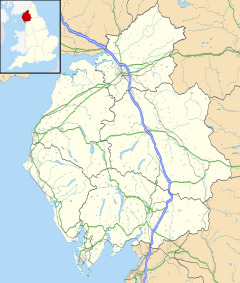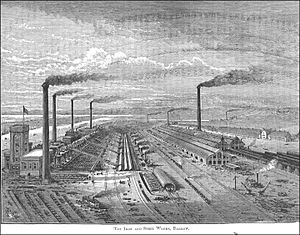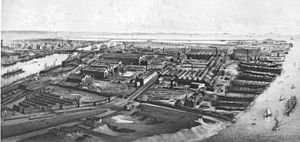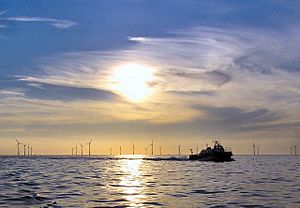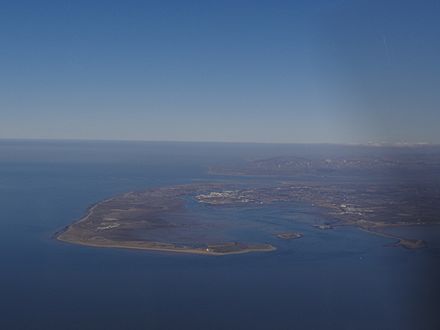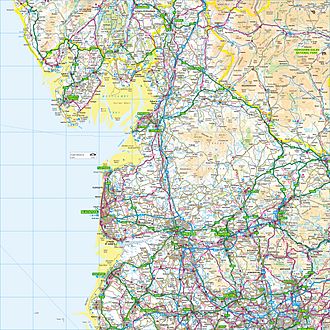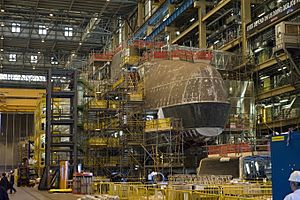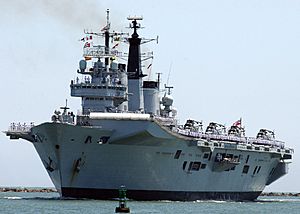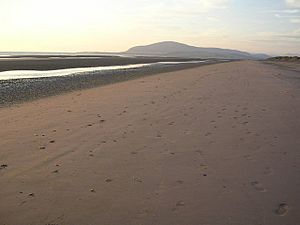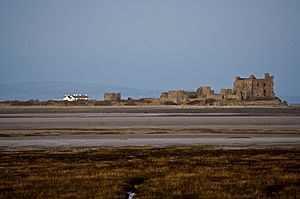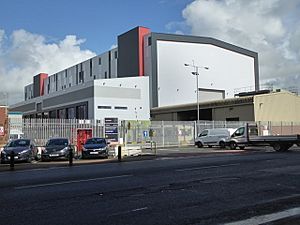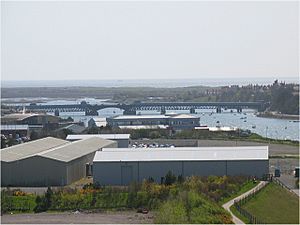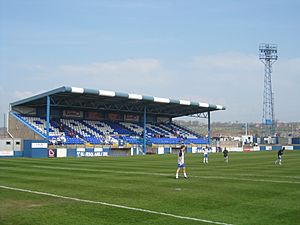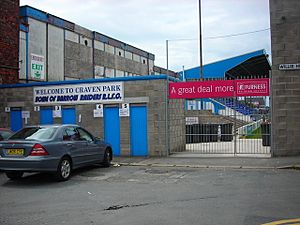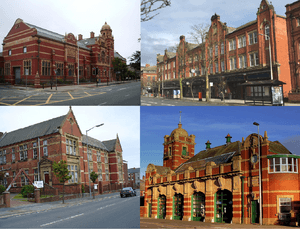Barrow-in-Furness facts for kids
Quick facts for kids Barrow-in-Furness |
|
|---|---|
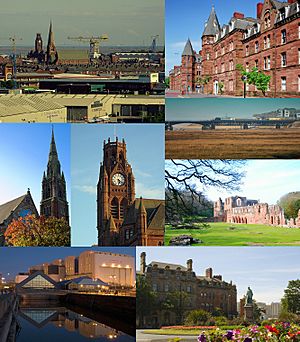 Clockwise from the upper left: Central Barrow with the skyline of Blackpool also visible, Barrow Island, Walney Bridge and Furness College, Furness Abbey, Ramsden Square, Dock Museum and DDH, Barrow Town Hall and St. Mary's Church |
|
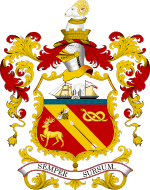 Coat of arms of Barrow-in-Furness |
|
| Population | 55,489 (2021 Census) |
| Demonym | Barrovian |
| OS grid reference | SD198690 |
| • London | 297 mi (478 km) |
| Civil parish |
|
| Unitary authority |
|
| Ceremonial county | |
| Region | |
| Country | England |
| Sovereign state | United Kingdom |
| Post town | BARROW-IN-FURNESS |
| Postcode district | LA13, LA14 |
| Dialling code | 01229 |
| Police | Cumbria |
| Fire | Cumbria |
| Ambulance | North West |
| EU Parliament | North West England |
| UK Parliament |
|
Barrow-in-Furness is a port town and civil parish in Cumbria, England. It's located on the Furness peninsula, near the Lake District. The town is surrounded by Morecambe Bay, the Duddon Estuary, and the Irish Sea. In 2021, Barrow had a population of 55,489 people. This makes it the second largest urban area in Cumbria.
People from Barrow are called Barrovians. In the Middle Ages, Barrow was a small village. Furness Abbey, a powerful monastery, controlled the local economy. In the 1800s, large amounts of iron ore were found nearby. This led to the growth of factories that made steel. For a while, the Barrow Hematite Steel Company had the world's largest steelworks.
Barrow's steel industry helped it become a major builder of naval ships. This became even more important during World War I. After World War II, the steelworks closed. The Vickers shipyard became Barrow's main industry. Many Royal Navy ships and most of its nuclear submarines were built here.
After the Cold War, there was less demand for military ships. This caused unemployment in Barrow. However, the BAE Systems shipyard is still very active. It's the UK's largest shipyard by workforce. It is currently expanding for the new Dreadnought-class submarine program. A new class of nuclear submarines, linked to the AUKUS military alliance, will also be designed and built in Barrow.
Today, Barrow is also important for making energy. It has many offshore wind farms. These include one of the world's largest offshore farms.
Contents
- What's in a Name? Barrow's History and Nicknames
- A Look Back: Barrow's Past Through the Ages
- How Barrow is Governed
- Barrow's Location and Natural Beauty
- People of Barrow: Population and Diversity
- Barrow's Economy: Jobs and Industries
- How People Work in Barrow
- Getting Around Barrow: Transport Links
- Sports in Barrow
- Barrow's Culture: Art, Music, and More
- Life in Barrow: Community and Challenges
- Learning in Barrow: Schools and Colleges
- Images for kids
- See also
What's in a Name? Barrow's History and Nicknames
The name "Barrow" first referred to an island called Barrai around 1190. This island later joined the mainland. The name likely means "island with a headland."
Fun Nicknames for Barrow
In the late 1800s, Barrow was called "the English Chicago". This was because it grew so quickly in industry and size. More recently, it's been called the "capital of blue-collar Britain". This shows its strong working-class identity. People also joke that Barrow is at the end of the longest cul-de-sac in the country. This is because of its isolated location.
A Look Back: Barrow's Past Through the Ages
People have lived in the Barrow area for thousands of years. Evidence of Neolithic people has been found on Walney Island. Viking silver coins found in 2011 show that Norse settlers were here in the early 800s. Many local names, like Yarlside and Ormsgill, come from Old Norse.
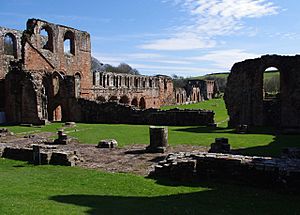
In the Middle Ages, Furness Abbey controlled the area. The monks found iron ore, which became important for the local economy. By the 1400s, the Abbey was one of the richest in England. The monks built a wooden tower on Piel Island to help with trade. Barrow itself was a small village that relied on farming and fishing. Some old cottages and farmhouses in Newbarns and Ormsgill date back to the 1600s.
How Barrow Grew: The 1800s Boom
In 1839, Henry Schneider found large amounts of iron ore. He and others started the Furness Railway in 1846. This railway moved iron ore and slate from mines to the coast. Docks were built between 1863 and 1881. The first dock, Devonshire Dock, opened in 1867. Prime Minister William Ewart Gladstone even said Barrow could become "another Liverpool."
Investors realized they could make more money by turning iron ore into steel. Schneider and Sir James Ramsden built huge blast furnaces. By 1876, these formed the world's largest steelworks. Its success was due to local iron ore, coal, and easy transport. The railway brought ore to the town, where steel was made for shipbuilding and other products.
Barrow's population grew very fast. In 1851, only about 700 people lived here. By 1871, it was over 18,000, and by 1881, nearly 47,000! Many people moved from other parts of England, Scotland, and Ireland. To create more jobs, James Ramsden also started the Barrow and Calcutta Jute Company in 1870. The Barrow Jute Works employed 2,000 women at its busiest time.
The sheltered area between Barrow and Walney Island was perfect for a shipyard. The first ship was launched in 1852. In 1871, the Barrow Shipbuilding Company started. It built many parts of ships itself, which was unusual.
During these busy years, Ramsden planned the town to house the many workers. Barrow is one of the oldest planned towns in the UK. Its center has a grid of well-built houses. Ramsden became Barrow's first mayor in 1867. The impressive red sandstone town hall was built in 1887.
In 1897, the Sheffield steel company Vickers took over the shipyard. Vickers built Vickerstown on Walney Island to house its employees. They also hired a famous architect, Sir Edwin Lutyens, to design Abbey House for their managing director.
Barrow in the 1900s: Wars and Submarines
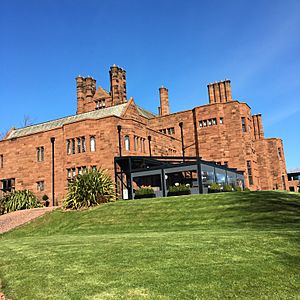
By the 1890s, the shipyard was building many warships for the Royal Navy. The UK's first submarine, Holland 1, was built in 1901. By 1914, Vickers had built 94% of the UK's advanced submarine fleet. Vickers also built airships. The most famous was HMA No. 1, nicknamed the Mayfly. It was the first of its kind in the UK. Famous ships built in Barrow include the Japanese battleship Mikasa and the aircraft carriers HMS Invincible and HMAS Melbourne.
During World War I, many workers came to Barrow. The town's population reached about 82,000. Thousands of local men fought, and 616 were killed.
In World War II, Barrow was a target for the German air force. They wanted to stop the town's shipbuilding. The worst attacks were in April and May 1941. Bombs often missed the shipyards and hit homes instead. 83 people were killed, and 11,000 houses were damaged. Many people left the town to escape the bombing. Barrow's industry kept helping the war effort. Winston Churchill even visited to launch the aircraft carrier HMS Indomitable.
Barrow's population peaked again in 1951 with 77,900 people. But mining and steel-making began to decline. The ironworks closed in 1963, and the steelworks in 1983. This left the shipyard as Barrow's main industry. From the 1960s, it focused on building submarines. The UK's first nuclear submarine, HMS Dreadnought, was built here in 1960. Many other nuclear submarines followed.
The end of the Cold War in 1991 meant fewer military contracts. This caused unemployment. The shipyard's workforce shrank from 14,500 in 1990 to 5,800 in 1995.
Barrow Today: The 2000s and Beyond
In 2002, Barrow had a health issue caused by bacteria from an air conditioning unit. Seven people sadly died. The council and an employee were later fined for health and safety problems.
Since 2006, Barrow has seen a lot of investment in renewable energy. The Barrow Offshore Wind Farm was built, followed by Ormonde Wind Farm and Walney Wind Farm. Walney Wind Farm became the largest offshore wind farm in the world. These wind farms are off Walney Island. They have 162 turbines and provide energy for over half a million homes.
From the mid-2010s, BAE Systems has invested a lot in the shipyard. This expansion is for the new Dreadnought-class program. In 2023, it was announced that a new class of nuclear submarines, linked to the AUKUS military alliance, will also be designed and built in Barrow. This will secure the shipyard's future for a long time. There are also plans to use old gas fields in Morecambe Bay to store carbon dioxide.
How Barrow is Governed
Barrow is the largest town in the Westmorland and Furness district. It used to be part of the historic county of Lancashire.
Local Government Changes
From 1974 to 2023, Barrow was part of Cumbria county. On April 1, 2023, Barrow Borough Council and Cumbria County Council merged. They formed the new Westmorland and Furness district. At the same time, new local areas called "wards" were created within Barrow.
Who Represents Barrow?
The Barrow-in-Furness UK Parliament constituency started in 1885. The first MP was David Duncan. Since 1945, the seat has usually been held by the Labour Party. In the 2024 General Election, Michelle Scrogham became the MP for Barrow and Furness.
Barrow's Location and Natural Beauty
Barrow is at the very end of the Furness peninsula. It's on the north-western edge of Morecambe Bay. To the south is the Duddon Estuary, and to the east is the Irish Sea. Walney Island protects Barrow from the Irish Sea. It's connected to Barrow by the Jubilee bridge. Both Morecambe Bay and the Duddon Estuary have large areas of quicksand and fast-moving tides.
Barrow's town center and industrial areas are on flat land near the coast. Hilly areas rise to the east, with the highest point at Yarlside. Barrow's soil was formed during the last Ice Age from rocks eroded from the Lake District National Park.
Barrow is the only big town in South Cumbria. Nearby towns include Dalton-in-Furness, Ulverston, and Millom.
Islands Around Barrow
Most of Barrow is protected by Walney Island. This island is about 14 miles (22.5 km) long. Around 13,000 people live on Walney, mostly in Vickerstown. This area was built for shipyard workers. Barrow Island used to be separate but is now connected to the town. Other islands nearby include Piel Island, which has a castle that protected the harbor.
Green Spaces and Parks
Barrow has many parks and open spaces. Walney North and South Nature Reserves are protected areas. Formal woodland areas include Hawcoat/Ormsgill Quarry and Sowerby Wood. Barrow Park is the largest park in the town. There are also many smaller parks and playgrounds.
Barrow's Weather
| Climate data for Walney Aerodrome (1991–2020) | |||||||||||||
|---|---|---|---|---|---|---|---|---|---|---|---|---|---|
| Month | Jan | Feb | Mar | Apr | May | Jun | Jul | Aug | Sep | Oct | Nov | Dec | Year |
| Mean daily maximum °C (°F) | 7.1 (44.8) |
7.5 (45.5) |
9.3 (48.7) |
12.1 (53.8) |
15.0 (59.0) |
17.2 (63.0) |
18.9 (66.0) |
18.8 (65.8) |
17.1 (62.8) |
13.8 (56.8) |
10.3 (50.5) |
7.9 (46.2) |
12.9 (55.2) |
| Mean daily minimum °C (°F) | 3.0 (37.4) |
2.9 (37.2) |
3.9 (39.0) |
5.8 (42.4) |
8.4 (47.1) |
11.2 (52.2) |
13.1 (55.6) |
13.2 (55.8) |
11.3 (52.3) |
8.7 (47.7) |
5.9 (42.6) |
3.5 (38.3) |
7.6 (45.7) |
| Average rainfall mm (inches) | 91.2 (3.59) |
75.6 (2.98) |
73.2 (2.88) |
54.1 (2.13) |
57.4 (2.26) |
68.2 (2.69) |
79.3 (3.12) |
89.9 (3.54) |
94.2 (3.71) |
117.8 (4.64) |
112.6 (4.43) |
113.3 (4.46) |
1,027 (40.43) |
| Average rainy days (≥ 1 mm) | 15.6 | 12.4 | 13.0 | 10.6 | 10.2 | 9.6 | 11.3 | 12.2 | 12.0 | 15.2 | 16.8 | 16.6 | 155.4 |
| Source: Met Office | |||||||||||||
People of Barrow: Population and Diversity
In 2021, the Barrow council district had a population of 67,407. The population within Barrow town itself was 55,489. Most people in Barrow are White British. Other groups include Asian, Black, and Mixed Race people. Many Barrovians are descended from people who moved here from Scotland, Ireland, and other parts of England in the late 1800s.
Barrow has connections with China. In 2014, Chinese state television made a documentary about it. This included a visit by a Chinese diplomat in 1896 and the discovery of old Chinese coins.
Most people in Barrow speak English as their main language. Other languages spoken include Tagalog, Chinese dialects, and Polish.
Faith in Barrow
In 2021, over half of Barrow's population said they were Christian. Many people also said they had no religion or chose not to say. Other religions include Islam and Buddhism. Conishead Priory, a Buddhist center, is near Barrow.
Barrow's Economy: Jobs and Industries
Historically, Barrow's economy was all about manufacturing. The Barrow Hematite Steel Company and Vickers Shipbuilding and Engineering were very important. Today, manufacturing is still the biggest job sector. BAE Systems is the largest employer, with about 12,000 employees. This number is expected to grow by another 5,000.
Shipyard and Port Activities
Barrow has been building ships and submarines for about 150 years. The Ottoman submarine Abdül Hamid, built in 1886, was the first submarine to fire a live torpedo underwater. Most of the Royal Navy's submarines have been built in Barrow.
The BAE Systems Maritime – Submarines shipyard in Barrow is the UK's largest. It was expanded in 1986 with the Devonshire Dock Hall (DDH). This huge building is 51 meters (167 ft) high and 268 meters (879 ft) long. It allows ships and submarines to be built in a controlled environment. A giant shiplift can lower completed vessels into the water. The DDH is now even bigger, making it one of Europe's largest shipbuilding complexes.
The shipyard is building the new Astute-class submarine and Dreadnought-class submarines. BAE Systems is investing £300 million in the shipyard for these projects. This will create thousands of new jobs. In 2023, it was announced that Barrow will also design and build a new class of nuclear submarines for the AUKUS military alliance.
The Port of Barrow is owned by Associated British Ports Holdings. It can handle large ships. The main docks are Buccleuch Dock, Cavendish Dock, Devonshire Dock, and Ramsden Dock. The port exports things like wood pulp and limestone. It also handles nuclear materials for the Sellafield plant.
James Fisher & Sons, a company that provides services to the marine industry, was founded in Barrow in 1847. It's the largest company headquartered in Cumbria.
Making Energy in Barrow
In 1985, gas was found in Morecambe Bay. This gas is processed at the Rampside Gas Terminal in Barrow. Barrow is part of 'Britain's Energy Coast'. It has many wind farms, mostly offshore. These include Walney Wind Farm, West Duddon wind farm, Barrow Offshore Wind Farm, and Ormonde Wind Farm. Walney Wind Farm was once the largest offshore wind farm in the world.
There are also plans to use the old gas fields in Morecambe Bay to store carbon dioxide.
Fun and Tourism in Barrow
Barrow is often called a "gateway to the lakes" because it's only about 20 minutes from the Lake District. The town has several tourist attractions. The most popular free attraction is the Dock Museum. It tells the story of Barrow's history, including the steelworks and shipyard.
Walney Island has two famous nature reserves, North and South Walney. Barrow also has several beaches like Earnse Bay and Biggar Bank. These are popular for sunbathing and kitesurfing. The historic ruins of Furness Abbey and Piel Castle are also popular places to visit. South Lakes Safari Zoo, one of Europe's leading conservation zoos, is near Barrow.
Barrow town center has a large indoor market and Portland Walk Shopping Centre. There are also many retail parks with supermarkets, shops, gyms, and Cumbria's largest cinema.
Making Barrow Better: Regeneration Projects
Barrow has been working on urban regeneration since the 1990s. The Portland Walk Shopping Centre opened in 1998. The Hindpool Retail Parks and Dock Museum were built on old industrial sites. Recent projects include expanding Furness College and building a new Furness Academy.
The Waterfront is a big project to redevelop the docklands. It includes a new marina, homes, restaurants, and hotels. There's also a possibility of a cruise ship terminal. This project has received funding to help it move forward. BAE Systems' £300 million investment in the shipyard is also a huge development. It includes new buildings like the Central Yard Complex Facility.
How People Work in Barrow

BAE Systems is the biggest employer in Barrow. Other major employers include the NHS (through Furness General Hospital), Kimberly Clark paper mill, and Westmorland and Furness Council.
Barrow has a higher percentage of workers in manufacturing than the national average. Many people who live in Barrow also work in Barrow. A significant number of people also work at the Sellafield nuclear facility nearby.
Getting Around Barrow: Transport Links
Roads in Barrow
Barrow's main road is the A590. It connects Barrow to the M6 motorway. The A595 links Barrow to West Cumbria. Abbey Road is the main road through central Barrow. The Walney Bridge connects Barrow Island to Walney Island.
Bus Services
Bus services in Barrow are run by Stagecoach North West. Many bus routes start and end near the town hall. Buses go to local suburbs and villages, as well as to towns like Ulverston and Kendal.
Train Connections
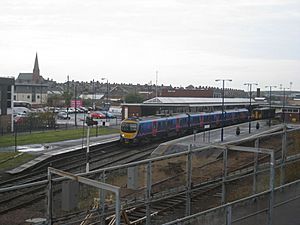
Barrow-in-Furness railway station connects to places like Carlisle to the north and Lancaster to the east. Many daily trains go to Manchester. Barrow also has a second station, Roose.
Barrow used to have a double-decker tram service between 1885 and 1932.
Air Travel
Barrow/Walney Island Airport is owned by BAE Systems. It operates flights to various UK cities for business. The airport was expanded in 2018. Manchester Airport is the closest major airport. A heliport was built in 2018 to support the offshore energy sector.
Sea Journeys
The Port of Barrow is a minor port. In the past, passenger ferries operated from Barrow to places like the Isle of Man and Scotland. For a short time in the 1880s, you could even travel across the Atlantic to New York City from Barrow. There are plans to build a cruise ship terminal in Barrow in the future.
Sports in Barrow
Football Fun
Barrow is the town's professional football team. They play in EFL League Two, the fourth tier of English football. They are nicknamed the Bluebirds and play at Holker Street. In 1990 and 2010, they won the FA Trophy. In 2020, Barrow won the National League, returning to the Football League.
Famous football players from Barrow include England internationals Emlyn Hughes and Gary Stevens.
Rugby League Action
Barrow is known for rugby league. The town's semi-professional team, Barrow Raiders, plays at Craven Park. In the 1950s, the team won the Challenge Cup. Many local players have played professionally, including brothers Ade and Mat Gardner.
Golf Courses
Barrow has two large golf clubs: Barrow Golf Club and Furness Golf Club. Furness Golf Club, founded in 1872, is one of the oldest in England. It's located on Walney Island, very close to the Irish Sea.
Motor Sports Excitement
Barrow has hosted speedway racing since the 1920s. The town has also produced talented motorcyclists and kart racers. In 2020, Max Davies became the first person from Barrow to represent Team GB at the ROK World Finals in karting.
Other Sports to Enjoy
Barrow is home to the Walney Terriers American Football club. One of the town's most famous annual events is the Keswick to Barrow (K2B). This is a 40-mile (64 km) walking and running event that has raised millions for charity since 1967.
Barrow's Culture: Art, Music, and More
Barrow has many historic buildings and natural sites. It has 274 Listed Buildings and four SSSIs.
Barrow's Buildings: A Mix of Styles
Barrow is one of Britain's few planned towns. Its older parts have wide, tree-lined streets. The town center has many Victorian and Edwardian era buildings, like the Town Hall and Main Public Library. Many buildings were made from local sandstone, giving them a brown or red color.
The tallest building in Barrow is Devonshire Dock Hall at 51 meters (167 ft). The turbines of Ormonde Wind Farm are even taller at 152 meters (499 ft). Most homes in Barrow are Victorian terraces.
Music and Arts Scene
Barrow has produced several notable musicians, including Thomas Round, a singer, and Glenn Cornick, the original bass guitarist for Jethro Tull. More recently, hip-hop DJ Aim has been successful.
Artist Keith Tyson, a Turner Prize winner, worked at the shipyard. Peter Purves, a famous TV presenter, started his acting career in Barrow. Today, The Forum is a main venue for theater. The Vue Cinema is the only cinema in town.
Barrow in Books
- Barrow and Vickerstown appear in The Railway Series (which became Thomas the Tank Engine). It's where the fictional Island of Sodor connects to mainland Britain.
- The poet William Wordsworth wrote about Furness Abbey.
- The Portuguese poet Fernando Pessoa wrote sonnets about "Barrow-on-Furness."
- The novel Career of Evil by J. K. Rowling (writing as Robert Galbraith) is partly set in Barrow.
Local Media
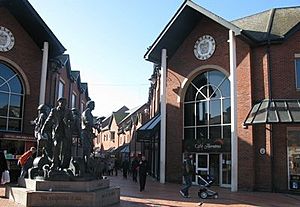
Barrow has a local newspaper, The Mail. For radio, there's the local community station CandoFM and Heart North West. BBC Radio Cumbria also serves the area.
Several TV personalities are from Barrow, including chef Dave Myers (one half of the Hairy Bikers) and newsreader Steve Dixon. The TV show Housewife, 49, starring Victoria Wood, was filmed in parts of Barrow.
Barrow's Unique Dialect
The local dialect in Barrow, called Barrovian, sounds a bit like Lancashire accents. It's been influenced by people who moved here from Scotland, Ireland, and other parts of England.
Nightlife and Food
Barrow has many pubs and working men's clubs. The town's largest nightclub is Manhattans.
A traditional favorite food in Barrow is the meat and potato pie. Pie shops are common. Barrow was also home to a soft drink company called Marsh's, which made a unique sarsaparilla-flavored drink called Sass. The coasts around Barrow have cockle beds, and there's an oyster farm on Walney.
Life in Barrow: Community and Challenges
Barrow's culture reflects its strong working class traditions. In 2008, Barrow was named one of the most working-class places in the UK. This was based on things like the number of fish and chip shops and working men's clubs.
Some areas in Barrow face more challenges than others, especially concerning health. However, other areas, like Newbarns and Roose, are among the least challenged in England.
Learning in Barrow: Schools and Colleges
Barrow has many schools, including fifteen primary schools and three secondary schools: Furness Academy, St. Bernard's Catholic High School, and Walney School. Chetwynde School is a school for ages 4 to 18.
For further education, there's Furness College. It merged with Barrow Sixth Form College in 2016. Furness College offers technical courses and some university-level programs. Plans were approved in 2023 for a University of Cumbria campus on Barrow Island, expected to open in 2024.
The main library in Barrow is the Central Library in Ramsden Square. It also has a branch of the County Archive Service. Smaller libraries are on Walney, Roose, and Barrow Island.
Images for kids
-
Cornmill Crossing in 1895 (a former goods-depot on the Furness Railway), a retail park now exists on the site
-
Tesco is a significant employer, with several outlets across Barrow
See also
 In Spanish: Barrow-in-Furness para niños
In Spanish: Barrow-in-Furness para niños


